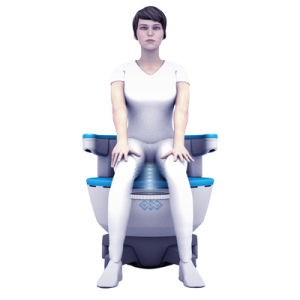Our clinic gets so many calls asking if we have “the chair”. We’ve all seen and heard the ads that promise the quick and easy fix for incontinence…and everyone loves the thought of the added bonus of improved sexual wellness…all the while staying fully clothed!
Our Pelvic Floor Physiotherapist, Leona Ham, recently visited a clinic in Calgary to experience this herself. She had a very positive, fact-finding meeting at the clinic with an employee who treats their clients. This meeting resulted in a warm referral system. Leona writes about her experience below.
“The Kegal Throne”
So what’s the deal with the pelvic floor chairs?
Since the rising popularity of “the chair”, I get asked weekly about the chairs that use EMF (electromagnetic forces) to contract the pelvic floor. The two brands that I have seen advertised locally are called Emsella and Urospot. I recently went to sit on an Emsella chair.

Photo from https://btlaesthetics.com/en
My experience: The staff member who assisted me was very professional and did her best to answer all my questions. I really appreciated her humility when I asked questions she could not answer. She was open and honest to admit she didn’t know.
What I felt and observed:
How you sit on the chair is important. I played around with my posture and pelvic position on the chair and some suspicions I had were confirmed. For instance, if you slouch or sit too far forward in the chair then your buttock muscles will be the primary muscles that contract. If this is not identified by the staff member and the patient is unaware of where and what they should be feeling when the pelvic floor muscles are contracting, then likely their brain will create the wrong muscle memory for squeezing the pelvic floor.
I could feel my superficial pelvic floor muscles that surround the labia and clitoris being stimulated like what you might feel when you place a TENS machine (small, tingling, electrical impulses) on the surface of your skin. The sensation of tingling would intermittently increase in intensity. The elevation in intensity may have created a muscle contraction, but the sensation of tingling was so strong that it was difficult to tell. The sensation of tingling remained with me for about 1-2 hours after I got off the chair. Based on this experience and my clinical experiences of working with patients, this temporary increase in stimulation will only be beneficial in creating long term changes if the patient were also given pelvic floor exercises to do at home. Currently, the research that I have found on the chairs, only follows the participants for 6 months after use of the chair. I think this is because it is unlikely that after that period, the changes that participants originally got are likely worn off unless they continued some sort of regular pelvic floor exercise regimen after stopping the chair sessions.

Photo from https://btlaesthetics.com/en
My educated opinion:
My opinion is based on my limited knowledge of how exactly the EMF technology works in comparison to a TENS. My experience with TENS and other electrical modalities is that when you are using a machine to tighten a muscle the machines use is only to “kick start” the muscle and then you must remove the machine and have the patient complete exercises for them to truly regain function of the muscles that have become weak.
Do I think the chair could help any of the patients I see in my practice?
It could potentially help patients that have a weak pelvic floor or are coming for reasons around sexual drive. I do believe that the help will be temporary unless it is partnered with a pelvic floor physiotherapist.
When is it not helpful for patients?
In my professional opinion, these chairs should NOT be used as a primary source of treatment (and may even be contraindicated) if you are experiencing pelvic pain, back pain, hip pain, prolapse, urinary urgency, bowel issues, or if you have pelvic floor muscles that are not completely relaxing. In these cases I urge you to seek out the care of a pelvic floor physiotherapist first to make sure you aren’t doing anything that will work against your healing.
In summary, does the chair work?
It is hard to say. Does advertising work? Absolutely. Could it be helpful? Yes, for some patients, but I cannot stress enough that this can not be the only tool used with the patient. The human body is too complex and research has proven over and over again that active therapy is superior to passive therapy. Muscles can atrophy for multiple reasons. Age and disuse are key factors that contribute to muscle loss. Age is mostly a factor if you are not living an active life. Disuse falls into the old cliché – use it or lose it.
When I get questions about the chair, I am always happy to answer them. You may want a second opinion or simply be curious if it would be the right fit for you. Please feel free to book in for a 15-minute complimentary consultation (In Person Meet & Greet or Virtual Meet & Greet). I look forward to meeting you and sharing more information about the options available for your healthy pelvic floor.
~~~~~~~~~~~~~~~~~~~~~~~~~~~~~~~~~~~~~~~~~~~~~
For more information about Leona Ham or an appointment with a Pelvic Floor Physiotherapist, please visit Leona’s page: CLICK HERE


